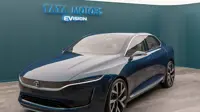Shedding the rugged image
By Mohini Bhatnagar | 09 Nov 2002
 Mumbai: Automobile manufacturers are phasing out or upgrading their existing models of sports utility vehicles (SUVs) and multi-utility vehicles (MUVs), spurred by increasing competition in the segment.
Mumbai: Automobile manufacturers are phasing out or upgrading their existing models of sports utility vehicles (SUVs) and multi-utility vehicles (MUVs), spurred by increasing competition in the segment. Toyota Kirloskar Motor (TKML) recently said it will change its Qualis model. This was announced after the launch of the New Qualis, the revamp of which cost Toyota Rs 4 crore. At the launch, TKML deputy managing director K K Swamy said the days of flogging the same model for five, 10 or 15 years in India are over.
No vehicle manufacturer can afford to be complacent in these times of cut-throat competition, which is probably why Toyota plans to change the Qualis model despite the fact that it continues to be one of the highest-selling utility vehicle models in India. During April-September 2002, sales of the Qualis rose by nearly 1 per cent to 14,376 units.
The need for change 
In recent times, all automobile companies in the MUV segment have begun targeting the urban personal segment as an assured growth venue. The rural market, plagued by the vagaries of farm income due to the dependence on the monsoon, has become increasingly unreliable. The urban auto market, on the other hand, is seen as more stable.
Till the launch of the Qualis, MUVs were mostly used by army personnel or Government of India officials, by rural folk, and by taxi and tour operators. They were perceived as rugged, stiff, difficult to drive, and noisy, with uncomfortable interiors.
The MUVs high-steel body, tough parts and Spartan interiors make it amenable to rough handling. The high ground clearance and high-power delivery make it suitable for driving over rough terrain places, hilly regions and deserts.
Recently, doubts were expressed in the West about the safety of SUVs and especially about their ability to travel at high speeds without toppling over. In India, speed is not as much an issue as good suspension and general ruggedness, to suit the poor road conditions in most Indian cities.
Change drive
Toyota sensed a great business opportunity in the personal urban segment and targeted the Qualis at this market from the beginning. The Qualis was thus positioned as an MUV with the attributes of a car. Advertisements of the Qualis focused on its being easy to drive and quiet, with a large seating capacity and comfortable interiors.
 The Qualis lived up to its promise; it has all the attributes of a car. It is pliant, quiet and easy to drive, with comfortable, plush interiors. Over the last two years, it has established itself as a family car, against the Sumo and the Safari from Tata Engineering and Locomotive Company (Telco) and the Armada and the Armada Grand from Mahindra & Mahindra (M&M), which still carry the image of tourist and commercial vehicles.
The Qualis lived up to its promise; it has all the attributes of a car. It is pliant, quiet and easy to drive, with comfortable, plush interiors. Over the last two years, it has established itself as a family car, against the Sumo and the Safari from Tata Engineering and Locomotive Company (Telco) and the Armada and the Armada Grand from Mahindra & Mahindra (M&M), which still carry the image of tourist and commercial vehicles.
Till the nineties M&M was the leader in the utility vehicles market. It first faced a threat to its position with the entry of the MUV Gypsy from Maruti Udyog in the late eighties. The liberalisation of the Indian economy in 1991 resulted in Telco entering the utility vehicles market with the Sierra, the Safari and the Sumo. The last one especially ate into the M&M share of the MUV market, reducing it to 50 per cent from 70 per cent. In 2000, M&Ms share fell further to 35 per cent.
M&M is Indias largest tractor manufacturer. In the past five years its tractor division has been going through a rough patch, in part due to rural depression following frequent failures of the monsoon in different parts of the country. The company has also been hit by increasing competition from companies like Tractor and Farm Equipment, Hindustan Machine Tools (HMT), Eicher and Escorts.
Rough terrain  With the tractor and rural market uncertain, the company has been targeting the urban market for the past two years, first with the Bolero and now with the Scorpio. Though the Bolero manages to sell, its not a big revenue earner.
With the tractor and rural market uncertain, the company has been targeting the urban market for the past two years, first with the Bolero and now with the Scorpio. Though the Bolero manages to sell, its not a big revenue earner.
Scorpio is M&Ms answer to the Qualis. Made under the Rs 550-crore Nasik-based Scorpio Project, the vehicle is available in three versions: Rev 116 with a 1998cc petrol engine, and 2.6 Turbo DI and 2.6 Turbo DX, both fitted with 2609cc diesel engine. All Scorpio versions come with factory-fitted ACs and posh and spacious interiors. It is a rugged vehicle that can negotiate through tough terrain and at the same time offers the seating and driving comfort of a car.
Where the Scorpio really scores is on the price. The vehicle is priced in the range of Rs 6 lakh to Rs 8 lakh, making it a great buying proposition, say auto analysts. Not surprisingly, the Scorpio logged over 1,000 bookings and generated more than 10,000 walk-ins and over 3,000 customer inquiries within eight days of its launch. Auto industry analysts, however, say the company will not find the going easy after the Scorpio launch. The Scorpio needs to generate enough volumes to enable the company to recover its Rs 500 crore investment. The price may be an effort to wean away buyers of top-end small cars and mid-sized cars, but huge volumes are unlikely to come from individual car buyers.
Competition galore  Telco, meanwhile, is making efforts to position the Sumo as a personal vehicle in the urban market. The company launched the Sumo+ and the Sumo Ex+, upgraded versions of the Sumo, last month. The Sumo is Telcos best-selling utility vehicle and has sold 2,20,000 units since its launch.
Telco, meanwhile, is making efforts to position the Sumo as a personal vehicle in the urban market. The company launched the Sumo+ and the Sumo Ex+, upgraded versions of the Sumo, last month. The Sumo is Telcos best-selling utility vehicle and has sold 2,20,000 units since its launch.
Being targeted at personal car-owners, the new versions have a more refined and softer look, and more seating comfort. The Ex+, positioned at the top end of the series, has a dual air-conditioning unit with an additional roof-mounted blower. It has contoured seats equipped with adjustable lumbar support for the driver and co-driver. After customer complaints about shortage of leg space in the earlier Sumo, Telco says the new versions have the largest leg space in the multi-utility category of vehicles.
 Telcos new plus series is priced at Rs 5.58 lakh ex-showroom Delhi for the ExEGR variant while the Ex+ Turbo variant comes for Rs 5.95 lakh and is positioned above the Sumo deluxe. At these prices the car is extremely attractive, as it carries nearly all the features of a Safari at a much more affordable price.
Telcos new plus series is priced at Rs 5.58 lakh ex-showroom Delhi for the ExEGR variant while the Ex+ Turbo variant comes for Rs 5.95 lakh and is positioned above the Sumo deluxe. At these prices the car is extremely attractive, as it carries nearly all the features of a Safari at a much more affordable price.
Clearly Telco is making an all-out effort to woo the personal segment. At present, 60 per cent of the total sales of the Sumo is to fleet operators, while 40 per cent is for personal use.
Other players
A host of global majors are making concrete plans of launching their SUVs here. General Motors plans to introduce its Panther; Ford is mulling over introducing its Ranger; Hyundai Motors is introducing the Terracan; Suzuki its Grand Vitara; while the Pajero from the Mitsubishi stable is already on the Indian roads. In the SUV segment internationally Toyota has the Landcruiser and the Prado and there are rumours that it may launch one of these here.
Last year (2001-02) the market sold about 110,000 utility vehicles, of which MUVs like the Tata Safari, the Toyota Qualis and Mahindras Bolero were about 40,000.
























